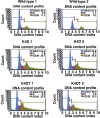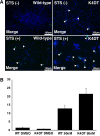Immortalization of cells derived from domestic dogs through expressing mutant cyclin-dependent kinase 4, cyclin D1, and telomerase reverse transcriptase
- PMID: 35185293
- PMCID: PMC8817002
- DOI: 10.1007/s10616-021-00504-0
Immortalization of cells derived from domestic dogs through expressing mutant cyclin-dependent kinase 4, cyclin D1, and telomerase reverse transcriptase
Abstract
Dog is the first animal that was established as a close partner of human beings. Based on the vast genetic diversity and breeding, dogs exhibit unique genetic evolution and diversity from Chihuahua to St. Bernard. The safety tests of the pharmacological products also included domestic dogs as the test subjects. Although the safety confirmation test of chemicals for human use is important, the welfare of experimental animals requires special consideration. In this study, we cultured domestic dog-derived primary fibroblasts isolated from their muscle tissues. Furthermore, we successfully immortalized them through lentivirus-mediated gene transfer of mutant cyclin-dependent kinase 4 (CDK4), cyclin D1, and telomere reverse transcriptase (TERT). We further demonstrated that the established immortalized domestic dog-derived fibroblasts retained the characteristics of the original parental cells. These cells might act a suitable in vivo model system to replace the implication of animals for evaluating the potential toxicity of pharmacological chemicals.
Supplementary information: The online version contains supplementary material available at 10.1007/s10616-021-00504-0.
Keywords: CDK4; Cyclin D1; Dog; Immortalization; Telomerase reverse transcriptase.
© The Author(s), under exclusive licence to Springer Nature B.V. 2021.
Conflict of interest statement
Conflict of interestThe authors declare that they have no conflict of interest.
Figures








Similar articles
-
Detailed chromosome analysis of wild-type, immortalized fibroblasts with SV40T, E6E7, combinational introduction of cyclin dependent kinase 4, cyclin D1, telomerase reverse transcriptase.In Vitro Cell Dev Biol Anim. 2021 Dec;57(10):998-1005. doi: 10.1007/s11626-021-00631-0. Epub 2021 Dec 10. In Vitro Cell Dev Biol Anim. 2021. PMID: 34888747
-
Establishment of an immortalized cell line derived from the prairie vole via lentivirus-mediated transduction of mutant cyclin-dependent kinase 4, cyclin D, and telomerase reverse transcriptase.Exp Anim. 2016;65(1):87-96. doi: 10.1538/expanim.15-0061. Epub 2015 Oct 23. Exp Anim. 2016. PMID: 26496927 Free PMC article.
-
Efficient immortalization of cells derived from critically endangered Tsushima leopard cat (Prionailurus bengalensis euptilurus) with expression of mutant CDK4, Cyclin D1, and telomerase reverse transcriptase.Cytotechnology. 2018 Dec;70(6):1619-1630. doi: 10.1007/s10616-018-0254-0. Epub 2018 Sep 17. Cytotechnology. 2018. PMID: 30225752 Free PMC article.
-
Immortalization of common marmoset-derived fibroblasts via expression of cell cycle regulators using the piggyBac transposon.Tissue Cell. 2022 Aug;77:101848. doi: 10.1016/j.tice.2022.101848. Epub 2022 Jun 2. Tissue Cell. 2022. PMID: 35714414
-
Tissue formation and tissue engineering through host cell recruitment or a potential injectable cell-based biocomposite with replicative potential: Molecular mechanisms controlling cellular senescence and the involvement of controlled transient telomerase activation therapies.J Biomed Mater Res A. 2015 Dec;103(12):3993-4023. doi: 10.1002/jbm.a.35515. Epub 2015 Aug 14. J Biomed Mater Res A. 2015. PMID: 26034007 Review.
Cited by
-
Immortalization of American miniature horse-derived fibroblast by cell cycle regulator with normal karyotype.PeerJ. 2024 Jan 26;12:e16832. doi: 10.7717/peerj.16832. eCollection 2024. PeerJ. 2024. PMID: 38288466 Free PMC article.
References
-
- Ananiev J, Tchernev G, Patterson JW, et al. The guardian of genome. Acta Medica Bulg. 2011;38:72–82.
-
- Fukuda T, Iino Y, Eitsuka T, et al. Cellular conservation of endangered midget buffalo (Lowland Anoa, Bubalus quarlesi) by establishment of primary cultured cell, and its immortalization with expression of cell cycle regulators. Cytotechnology. 2016;68:1937–1947. doi: 10.1007/s10616-016-0004-0. - DOI - PMC - PubMed
LinkOut - more resources
Full Text Sources
Research Materials

